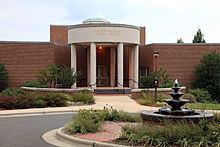|
University of North Carolina School of Law
The University of North Carolina School of Law (branded as Carolina Law[4]) is the law school of the University of North Carolina at Chapel Hill. Established in 1845, it is one of the oldest law schools in the United States and is the oldest law school in the state of North Carolina. History19th centuryOn December 12, 1842, following discussion in the North Carolina legal community, the trustees of the University of North Carolina authorized the university's president David L. Swain to review and establish a law professorship. In 1845, William Horn Battle was named the first professor of law, and legal instruction began at the university.[5] In the years following, assistant professors and later an organized faculty and law library were added.[citation needed] 20th centuryIn 1915, Margaret Berry became the first woman to graduate from the law school.[6] In the 1920s, the school began taking on much of the character of a modern law school, after the American Bar Association first published guidelines for schools. University President Harry Woodburn Chase was instrumental in leading the efforts for this reorganization over notable opposition, including the governor of North Carolina.[7] In June 1951, Harvey Beech, James L. Lassiter, J. Kenneth Lee, Floyd McKissick, and James Robert Walker Jr. became the first five Black students enrolled at the law school, leading the integration of the University of North Carolina at Chapel Hill.[8] McKissick and other Black students had demonstrated in court that a state law school for African Americans in Durham was not equal to that in Chapel Hill.[8] In March 1951, a U.S. Court of Appeals agreed and ordered UNC to stop excluding Black applicants.[9] Upon enrollment, the Black students "immediately confronted the intense pressure of trying to succeed in a highly competitive law school while dealing daily with racial bias from the very people tasked with fostering their educational success and with the pressure of having many other people's hopes and dreams riding on them."[10] Their first few months required a round-the-clock armed protective police escort due to Ku Klux Klan threats and other harassment,[11] but the students sometimes received more support from their peers than the school's administration.[12] For example, the student body voted to hold an integrated Barrister's Ball in 1952, but the university chancellor vetoed the social event.[13] Despite the racism and institutional challenges, Beech graduated in June 1952, "becoming the first African American graduate of the law school and UNC-Chapel Hill."[14] In 1962, Sylvia X. Allen became the first Black female student to graduate, and did so as the mother of six children.[15] As of 2023[update], the law school has 572 enrolled students and a student-faculty ratio of 8.8 to 1. The entering class of first-year law students in 2023 was composed of 179 students from 27 states, the District of Columbia, and Canada. Sixty percent of students were from North Carolina, and students of color made up 32.52% of the class. Sixty percent of incoming students were female, while 38% were male.[16][17] As of 2024, the University of North Carolina School of Law is ranked 20th (tied) in the nation by U.S. News & World Report.[18] AdmissionsFor the class entering in 2023, the school accepted 16.27% of applicants, with 37.99% of those accepted enrolling. The average enrollee had a 166 LSAT score and 3.78 undergraduate GPA.[16] Facilities The law school is currently located in Van Hecke-Wettach Hall, towards the southeastern side of the Chapel Hill campus, neighboring the School of Government and several athletic facilities. Van Hecke-Wettach Hall includes the Kathrine R. Everett Law Library, located primarily on four floors on the back side of the building. Centers and programsThe UNC School of Law is home to several centers that focus on issues of state and national interest:[19]
ClinicsClinics provide students with the opportunity to learn legal theory and put the legal theory to practice.[20]
Law journalsThe school is home to six student-edited law journals.[21] Founded in 1922, the North Carolina Law Review is the oldest law journal in the state.
Bar examination passageIn 2023, the overall bar examination passage rate for the law school’s first-time examination takers was 92.00%. The Ultimate Bar Pass Rate, which the ABA defines as the passage rate for graduates who sat for bar examinations within two years of graduating, was 94.33% for the class of 2021.[3] EmploymentAccording to the employment disclosures required by the American Bar Association, within ten months of graduation 86.77% of the class of 2022 obtained full-time, long-term, JD-required employment (i.e., as attorneys) and 10.05% obtained JD advantage employment. Two students (1.06%) enrolled in further graduate studies.[22] CostsThe total cost of attendance, including tuition, fees, and living expenses, at UNC for the 2017-2018 academic year was $49,562 for North Carolina residents and $66,193 for out-of-state students.[23] The Law School Transparency estimated debt-financed cost of attendance for three years is $176,368 for residents and $243,846 for nonresidents.[24] Notable alumniThere are more than 10,000 alumni of the University of North Carolina School of Law since its founding.[25] Roughly 40 percent of practicing North Carolina attorneys are Carolina Law graduates, more than any other law school in North Carolina.[25] Many have gone on to notable roles, including government offices, such as former US Senator and 2004 Vice Presidential candidate John Edwards, and former Chief of Staff to the President of the United States and former US Congressman, Mick Mulvaney. Additionally, many have served in positions in the North Carolina state government. Among these are the current and recent North Carolina governors (Cooper, Hunt, Holshouser, Moore, and Sanford) and (as of the 2021 term) three of seven North Carolina Supreme Court justices (Barringer, Newby, and Hudson) as well as one alumn currently serving on the Court of Appeals of Virginia (Frucci). Leadership
References
|
||||||||||||||||||||||||||
Portal di Ensiklopedia Dunia

